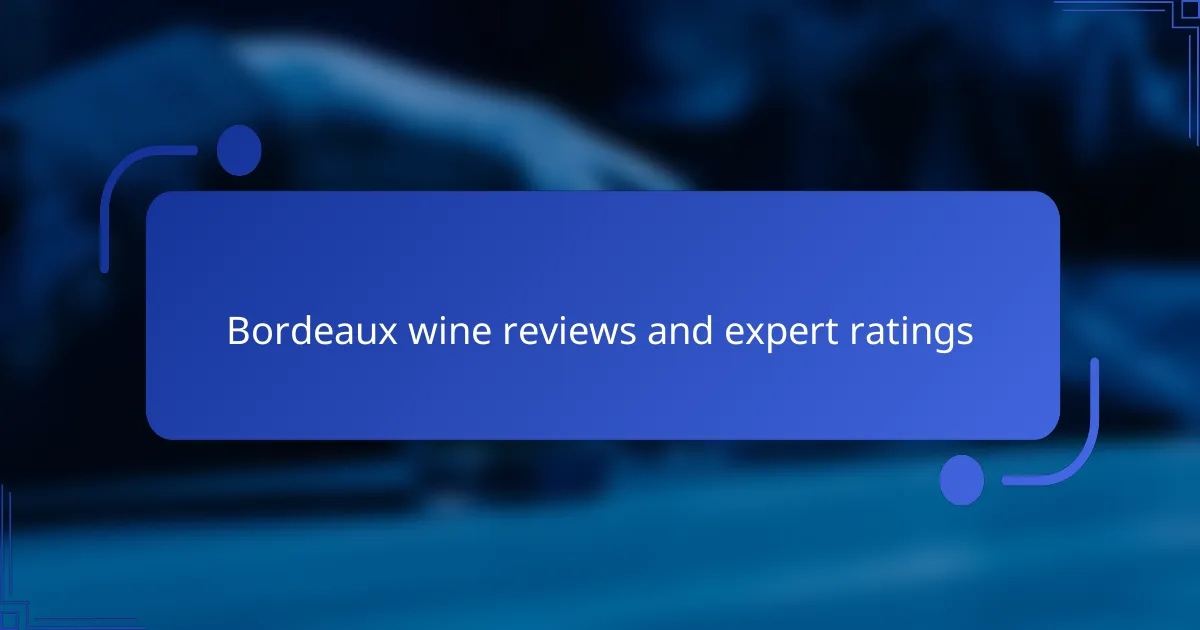
What are Bordeaux wines?
Bordeaux wines are wines produced in the Bordeaux region of France. This region is renowned for its high-quality red, white, and dessert wines. Bordeaux wines primarily consist of blends from grape varieties such as Cabernet Sauvignon, Merlot, and Cabernet Franc for reds. For whites, Sauvignon Blanc and Sémillon are commonly used. Bordeaux is one of the most famous wine regions globally, with a long history of viticulture dating back to Roman times. The region’s unique terroir, which includes diverse soils and microclimates, contributes significantly to the character of its wines. Bordeaux wines are classified into several categories, including AOC (Appellation d’Origine Contrôlée) and Grand Cru, indicating quality and origin. The Bordeaux wine market is highly influential, setting benchmarks for wine pricing and quality worldwide.
How is Bordeaux wine classified?
Bordeaux wine is classified primarily through the Bordeaux Wine Official Classification of 1855. This classification ranks wines from the Médoc and Graves regions based on their reputation and trading price. The top tier consists of five growths, known as “crus,” with Château Lafite Rothschild being the first growth. Additionally, Bordeaux wines are categorized into AOC (Appellation d’Origine Contrôlée) designations, which reflect specific geographic areas and production standards. The classifications also include Bordeaux Superieur and Bordeaux Clairet, indicating quality levels and styles. The system ensures quality assurance and helps consumers identify premium wines. The classification system has evolved but remains a crucial reference for wine enthusiasts.
What are the key regions within Bordeaux?
The key regions within Bordeaux are the Médoc, Saint-Émilion, Pomerol, Graves, and Sauternes. The Médoc is known for its Cabernet Sauvignon-dominant wines. Saint-Émilion produces Merlot-based wines that are highly regarded. Pomerol is famous for its rich, velvety Merlot wines. Graves is recognized for both red and white wines, particularly Sauvignon Blanc. Sauternes is renowned for its sweet dessert wines made from botrytized grapes. Each region has its unique terroir and winemaking traditions that contribute to the diversity of Bordeaux wines.
What grape varieties are commonly used in Bordeaux wines?
Bordeaux wines commonly use grape varieties such as Cabernet Sauvignon, Merlot, and Cabernet Franc. These varieties form the core of Bordeaux’s red wine production. Cabernet Sauvignon is known for its structure and aging potential. Merlot offers softness and fruitiness, making it widely popular. Cabernet Franc adds aromatic complexity and finesse. Other notable varieties include Petit Verdot, Malbec, and Carménère, though they are less prevalent. Bordeaux’s terroir and climate contribute to the unique characteristics of these grapes. The blending of these varieties is a hallmark of Bordeaux winemaking.
What factors influence the quality of Bordeaux wines?
The quality of Bordeaux wines is influenced by several key factors. These factors include the grape variety used, the terroir, and the winemaking techniques. Bordeaux wines are primarily made from Merlot, Cabernet Sauvignon, and Cabernet Franc grapes. The terroir encompasses the soil composition, climate, and geographical location, which significantly affect the grape’s growth.
Winemaking techniques, such as fermentation methods and aging processes, also play a crucial role. For instance, the use of oak barrels during aging can enhance the wine’s flavor profile. Additionally, vintage variations due to weather conditions impact the grape harvest and, consequently, the wine’s quality. According to a study by the University of Bordeaux, these factors collectively determine the sensory attributes and overall excellence of Bordeaux wines.
How does the terroir affect Bordeaux wine production?
Terroir significantly influences Bordeaux wine production through its unique combination of soil, climate, and topography. The diverse soil types, such as gravel, clay, and limestone, affect vine growth and grape characteristics. For instance, gravelly soils provide excellent drainage, which is beneficial for Cabernet Sauvignon. The climate in Bordeaux, characterized by maritime influences, impacts the ripening of grapes, ensuring balanced acidity and sugar levels. Additionally, the region’s varied microclimates contribute to the complexity of flavors in the wines produced. Historical records show that the specific terroir of Bordeaux has been recognized since the 18th century for its role in producing high-quality wines. This interaction of environmental factors creates distinct profiles for Bordeaux wines, making terroir a fundamental aspect of their production.
What role does the vintage play in Bordeaux wine quality?
The vintage significantly influences Bordeaux wine quality. Each vintage reflects the climatic conditions of that specific year. Factors such as temperature, rainfall, and sunlight affect grape ripeness and flavor development. For instance, a warm vintage may produce riper, fruit-forward wines. Conversely, a cooler vintage can yield wines with higher acidity and more structure. Historical data shows that exceptional vintages, like 2005 and 2010, received higher ratings from critics. These vintages are often noted for their balance and aging potential. Thus, the vintage serves as a critical indicator of quality in Bordeaux wines.
What are the common tasting notes for Bordeaux wines?
Bordeaux wines commonly exhibit tasting notes of dark fruits, such as blackcurrant and plum. They often have herbal and earthy undertones, including notes of tobacco and cedar. Additionally, Bordeaux wines can present hints of spice, like black pepper and clove. The wines also frequently show floral notes, particularly violet. The presence of oak aging contributes to flavors of vanilla and toast. These tasting notes vary between different Bordeaux varieties and vintages. Bordeaux wines are renowned for their complexity and depth of flavor.
What aromas and flavors can be expected from red Bordeaux wines?
Red Bordeaux wines typically exhibit a range of aromas and flavors, including dark fruits, tobacco, and earthy notes. Common fruit characteristics include blackcurrant, plum, and cherry. Secondary aromas often feature cedar, leather, and spice. These wines may also present herbal notes such as mint or eucalyptus. The complexity arises from the blend of grape varieties, primarily Cabernet Sauvignon, Merlot, and Cabernet Franc. Aging in oak barrels enhances flavors, adding vanilla and toast. The combination of these elements results in a rich and layered tasting experience.
What distinguishes white Bordeaux wines in terms of taste?
White Bordeaux wines are distinguished by their vibrant acidity and complex flavors. They typically feature citrus notes, such as lemon and grapefruit. Additionally, they often exhibit stone fruit flavors like peach and apricot. Many white Bordeaux wines have herbal undertones, including grass and fennel. The blend of Sauvignon Blanc and Sémillon grapes contributes to their aromatic profile. Oak aging can add layers of vanilla and toastiness. These wines are known for their refreshing quality and balanced structure. The unique terroir of Bordeaux enhances their minerality and depth, making them distinctive.

What are expert ratings for Bordeaux wines?
Expert ratings for Bordeaux wines are generally high, reflecting their quality and prestige. Many Bordeaux wines receive scores above 90 points from notable critics. For instance, Robert Parker’s Wine Advocate often rates top Bordeaux wines in the 90-100 point range. Similarly, Wine Spectator frequently awards high scores, with numerous wines achieving ratings of 95 or more. These ratings are based on factors like aroma, flavor, and aging potential. The 2016 Bordeaux vintage, for example, received widespread acclaim, with many wines rated above 95 points. This consistency in high ratings underscores Bordeaux’s reputation in the wine industry.
How do wine critics evaluate Bordeaux wines?
Wine critics evaluate Bordeaux wines through a systematic assessment of various attributes. They examine the wine’s appearance, aroma, taste, and finish. Critics also consider the wine’s balance, complexity, and aging potential. Specific criteria include color intensity, clarity, and viscosity. Aromas are assessed for their variety and depth, including fruit, floral, and earthy notes. On the palate, they analyze flavor profiles, texture, and acidity. The finish is evaluated for length and persistence. Critics often use a scoring system to quantify their evaluations. This method allows for objective comparisons among different Bordeaux wines.
What scoring systems are commonly used for Bordeaux wine ratings?
Common scoring systems used for Bordeaux wine ratings include the 100-point scale and the 20-point scale. The 100-point scale is widely recognized and utilized by critics like Robert Parker. This system assigns scores from 50 to 100, with higher scores indicating better quality. The 20-point scale, used by some European critics, scores wines on a scale of 0 to 20. Each system evaluates factors such as aroma, taste, and overall balance. Both scoring systems help consumers assess wine quality and make informed purchasing decisions.
How does expert opinion impact consumer choices for Bordeaux wines?
Expert opinion significantly influences consumer choices for Bordeaux wines. Consumers often rely on expert reviews and ratings when selecting wines. These evaluations provide insights into quality, taste, and value. A high score from a reputable critic can boost a wine’s sales dramatically. For instance, wines rated 90 points or higher by influential reviewers often see increased demand. Additionally, expert opinions can shape consumer perceptions of specific vintages and producers. This guidance is particularly important in the Bordeaux market, known for its complexity and variety. Overall, expert opinions serve as a trusted resource for consumers navigating their wine selections.
What are the most highly-rated Bordeaux wines of recent years?
The most highly-rated Bordeaux wines of recent years include Château Margaux 2015, Château Lafite Rothschild 2016, and Château Haut-Brion 2015. Château Margaux 2015 received a score of 98 points from Wine Spectator. Château Lafite Rothschild 2016 was rated 100 points by Robert Parker. Château Haut-Brion 2015 also achieved a score of 98 points from James Suckling. These wines are recognized for their exceptional quality and complexity. They exemplify the excellence of Bordeaux vintages in recent years.
What criteria are used to determine the best Bordeaux wines?
The best Bordeaux wines are determined by criteria such as terroir, grape variety, and vintage quality. Terroir refers to the unique environmental factors affecting the vineyard, including soil type and climate. The grape variety impacts flavor profiles and aging potential. Vintage quality is influenced by weather conditions during the growing season.
Expert ratings also play a significant role. Wine critics assess aroma, taste, and finish. Scoring systems, like the 100-point scale, provide a quantifiable measure of quality. Additionally, the wine’s balance, complexity, and structure are evaluated. Historical performance and reputation of the winery further contribute to the overall assessment.
These criteria collectively help in identifying and ranking the best Bordeaux wines in reviews.
Which Bordeaux wines have received the highest accolades in 2023?
In 2023, Bordeaux wines that received the highest accolades include Château Margaux, Château Lafite Rothschild, and Château Latour. Château Margaux was awarded a perfect score of 100 points by several wine critics. Château Lafite Rothschild also achieved a score of 99 points, highlighting its exceptional quality. Château Latour received a score of 98 points, further solidifying its reputation. These scores reflect expert evaluations from renowned wine publications and critics. The accolades are based on factors such as flavor profile, complexity, and aging potential.

How can consumers make informed choices about Bordeaux wines?
Consumers can make informed choices about Bordeaux wines by researching wine ratings and reviews. They should consult reputable wine critics and publications that specialize in Bordeaux wines. Notable sources include Wine Spectator and Robert Parker’s Wine Advocate. These sources provide expert ratings based on tasting notes and evaluations. Consumers can also explore vintage charts that indicate the quality of specific years. Understanding the grape varieties used in Bordeaux blends is essential. Common varieties include Cabernet Sauvignon, Merlot, and Cabernet Franc. Knowledge of the Bordeaux regions can guide selections. Areas like Médoc and Saint-Émilion have distinct characteristics. Lastly, attending wine tastings can enhance understanding and appreciation.
What should consumers look for in a Bordeaux wine review?
Consumers should look for specific attributes in a Bordeaux wine review. Key factors include the wine’s aroma, flavor profile, and overall balance. Reviews should detail the wine’s age and vintage, as these influence quality. The critic’s expertise and background can also affect the review’s reliability. Ratings from established wine publications provide additional context. Descriptions of the wine’s tannins and acidity are crucial for understanding its structure. Lastly, food pairing suggestions can enhance the consumer’s experience. These elements collectively guide consumers in making informed choices.
How can understanding expert ratings enhance wine selection?
Understanding expert ratings can significantly enhance wine selection by providing informed guidance on quality and taste. Expert ratings are derived from professional assessments of wine characteristics, including flavor profile, aroma, and aging potential. These ratings often reflect years of experience and knowledge in the field. For example, wines rated above 90 points by critics like Robert Parker are typically recognized for their exceptional quality. This can help consumers identify high-value options in a crowded market. Additionally, expert ratings can reveal trends in wine regions and varietals, assisting buyers in making educated choices. By relying on expert evaluations, wine enthusiasts can avoid subpar selections and discover new favorites.
What are some tips for selecting Bordeaux wines based on reviews?
When selecting Bordeaux wines based on reviews, prioritize expert ratings and consumer feedback. Look for wines with high scores from reputable sources like Wine Spectator or Robert Parker. Consider the vintage year, as some years yield better quality wines. Pay attention to tasting notes that describe flavor profiles and aromas. Check for reviews that mention the wine’s aging potential. Look for consistency in reviews across multiple platforms to ensure reliability. Consider the price point in relation to the ratings; higher-rated wines often command higher prices. Finally, explore regional specifics, as different appellations within Bordeaux can produce distinct characteristics.
How can consumers identify reliable wine critics and ratings?
Consumers can identify reliable wine critics and ratings by researching critics’ credentials and track records. Look for critics with formal training in wine tasting or viticulture. Check if they have published work in reputable wine publications. Reliable critics often have consistent evaluation methods and transparent scoring systems. Cross-reference ratings across multiple sources for consistency. Critics affiliated with recognized wine competitions or associations usually have credibility. Reviews from well-established platforms like Wine Spectator or Robert Parker are often trustworthy. Engaging with wine communities can also provide insights into critics’ reliability.
What common pitfalls should consumers avoid when reading Bordeaux wine reviews?
Consumers should avoid relying solely on subjective opinions in Bordeaux wine reviews. Many reviews are influenced by personal taste, which can vary widely. Additionally, consumers should be cautious of overly technical jargon. This language can be confusing and may not accurately reflect the wine’s quality.
Another pitfall is ignoring the vintage year. Bordeaux wines can vary significantly from year to year due to climate conditions. Consumers should also be wary of cherry-picked ratings. Some reviews may highlight only the most favorable aspects, omitting potential flaws.
Finally, consumers should not overlook the importance of the reviewer’s credibility. Established critics and publications often provide more reliable insights than anonymous sources. Understanding these factors can lead to more informed wine purchasing decisions.
Bordeaux wine reviews and expert ratings are central to understanding the quality and characteristics of wines from the Bordeaux region of France. This article provides an overview of Bordeaux wines, including classifications, key regions, grape varieties, and factors influencing quality, such as terroir and vintage. It also discusses common tasting notes for both red and white Bordeaux wines, expert evaluation methods, and the impact of ratings on consumer choices. Additionally, the article highlights highly-rated Bordeaux wines and offers tips for consumers on selecting wines based on reviews and expert opinions.
